- The recent Pentagon crash discussion on Rense.com has
almost entirely focused on photos of plane debris on the lawn. Since most
of the plane reportedly entered the building, we should also look for images
of debris inside the building. Unfortunately, such images are very hard
to come by since: (1) Much of the debris was burned and torn beyond recognition,
(2) Most FEMA photos in the public domain were taken on 9/14/01, after
much of the debris was cleared out of the building, (3) Most other photos
remain in the private hands of investigators, rescue workers, and others
who were inside the building. Many images are officially classified. The
following article attempts to bring together all known images sent to me
or in the public domain that show aircraft debris inside the Pentagon.
The images were either found online or sent to me by recovery workers to
be used with permission.
-
- First, we shall examine witness accounts of plane debris
inside the Pentagon. These were given by recovery workers, firefighters,
engineers, and Pentagon officials. Their statements help in interpreting
the various photos taken inside the building.
-
- I. Witness Accounts of Wreckage Inside the Building
-
- Witnesses described small pieces of plane debris in the
building. Because of the fire, much of the debris was burned beyond recognition.
Some pieces bore lime or yellow primer paint characteristic of internal
aircraft parts. Larger pieces included seats, cockpit circuitry, and a
landing gear. These accounts were drawn from Ron Harvey's excellent compilation
and from my own research.
-
- 1) "Most of the wreckage was in very small pieces
and most was carried out in drywall buckets. Some was large enough to identify
-- including the tail number on the aircraft. I don't think there's any
doubt about what it was and who owned it." (From a letter by an employee
of the Pentagon)
- http://www.humanunderground.com/11september/comments-general.html
-
- 2) "DC Matthew" wrote about his work inside
the Pentagon: "After about 15 minutes shoveling up chunks of carpet
and brick, I found a piece of circuit board, and a chunk of the
plane. When I say a chunk of it, I mean a piece that was about 3 oz
of twisted aluminum. The biggest piece I've seen so far is about the
size of a refrigerator."
- http://pub6.ezboard.com/foldmenonlinewhatdoyouthink.showPrevMessage?topicID=957.topic
-
- 3) While searching through wreckage inside the building,
firefighters Carlton Burkhammer and Brian Moravitz "spotted an intact
seat from the plane's cockpit with a chunk of the floor still
attached." Burkhammer also "spotted lime-green pieces
from the interior of the plane" within the building.
- http://www.msnbc.com/news/635293.asp
-
- 4) CMSgt. John Monaccio wrote: "I was in room 1B461.
The plane's inertia carried aircraft remains all the way through
the building coming to rest on the outside walls of our offices. We discovered
cockpit wreckage at our feet while attempting to rescue people from
a Navy operations area."
- http://www.geoffmetcalf.com/pentagon/pentagon-email_20020316.html
-
- 5) ARFF Captain Michael Defina said: "The only way
you could tell that an aircraft was inside was that we saw pieces of the
nose gear."
- http://www.nfpa.org/NFPAJournal/OnlineExclusive/Exclusive_11_01_01/exclusive_11.01.01.asp
-
- The Navy operations area, where the cockpit was discovered,
was in C-ring near the punchout hole. Many witnesses also recalled seeing
plane wreckage in A-E Drive next to the punchout hole. The following three
items were mentioned: a piece of the nose fuselage or nose cone, a landing
gear, and a tire tread.
-
- 6) Navy Lt. Commander David Tarantino described the A-E
Drive punchout hole: "They found an area where fire surrounded a hole
in a wall that was blown out. They heard cries from people who were trapped
and saw a plane tire."
- http://www2.hawaii.edu/~julianr/lexisnexis/tarantino.txt
-
- 7) Lt. Kevin Schaeffer from the Navy Command Center recalled
that "on a service road that circled the Pentagon between the B and
C rings, a chunk of the 757's nose cone and front landing
gear lay on the pavement a few feet away, resting against the B Ring
wall."
- http://www.pilotonline.com/special/911/pentagon3.html
-
- 8) "The nose of the plane just barely jutted out
into A/E Drive (the street that runs around the inside of the building).
It made a perfectly round, 5-foot hole in the wall. There was one set of
landing gear (presumably from the nose) out in A/E Drive. But most
of the plane's skin was in pieces not much bigger than a piece of
notebook paper." (From a letter by an employee of the Pentagon)
- http://www.humanunderground.com/11september/comments-general.html
-
- 9) "I thought it was a terrorist bomb. . . .But
then I saw the landing gear. It was on the ground in the alley between
the B and C rings. When I saw it there, not only did I realize an airplane
had struck the Pentagon but it was clear that the plane had come through
the E, D, and C buildings to get there." (Paul K. Carlton, Jr., U.S.
Air Force surgeon general, quoted by Dean Murphy, "September 11: An
Oral History," p. 216
-
- 10) Rep. Ted Tiahrt wrote: "In the C and B rings
the plane had punched a hole you could a drive a truck around in, and I
saw an airplane tire. It made it very real."
- http://wichita.bizjournals.com/wichita/stories/2002/09/09/story1.html
-
- 11) When LTC Victor Correa went back inside the Pentagon,
"he found out what caused the horrific attack he survived earlier
that morning; he saw the nose cone and the landing gear of
the airliner."
- http://www.army.mil/usar/news/2002/09-11anniv/herotellsall.html
-
- More witness accounts may be found on Ron Harvey's website:
http://www.dragonslair.pwp.blueyonder.co.uk/77/ffdd.html
-
- We shall now see some interesting images taken inside
the Pentagon on 9/12 and 9/13 -- photos of some of the objects mentioned
by these witnesses.
-
-
- II. Photos of Plane Wreckage Inside the Building
-
- Because of the destructive fire that raged inside the
building, most photos show only charred heaps of scrap. A good place to
look for plane wreckage is around structural columns which tore the plane
into pieces as it entered. Many columns show shredded or wrecked pieces
of metal wrapped around them or stacked beside them. The following photo
(by MDW Engineer Co. Fort Belvoir photographers) shows such a
column in D-ring near column 3H:
-
-
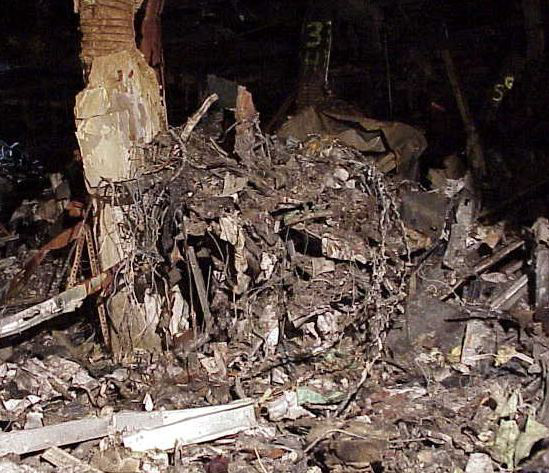
-
- Most of the heaped scrap is unrecognizable, but there
are two pieces of metal bearing yellow-green primer which were not burned
thoroughly. Charles Burkhammer similarly noted small lime-green pieces
of aircraft interior.
-
- Resting next to another pillar is another section of
lime-green material bearing clear rivet lines (photographed by FEMA's Jocelyn Augustino):
-
-
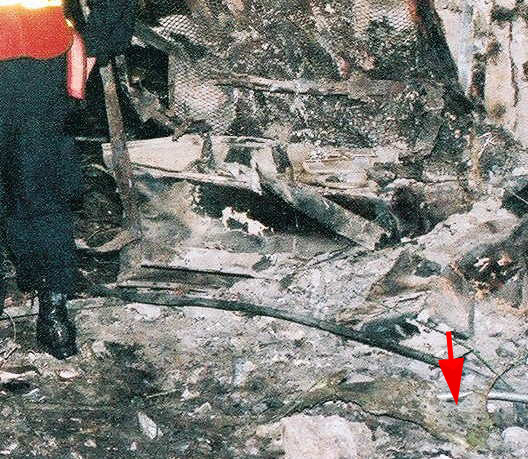
-
-
- Resting up against a bowed column is a large chunk of
burned metal. It is unclear whether this is a piece of the plane. Hanging
from the ceiling is a sheet of aluminum:
-
-
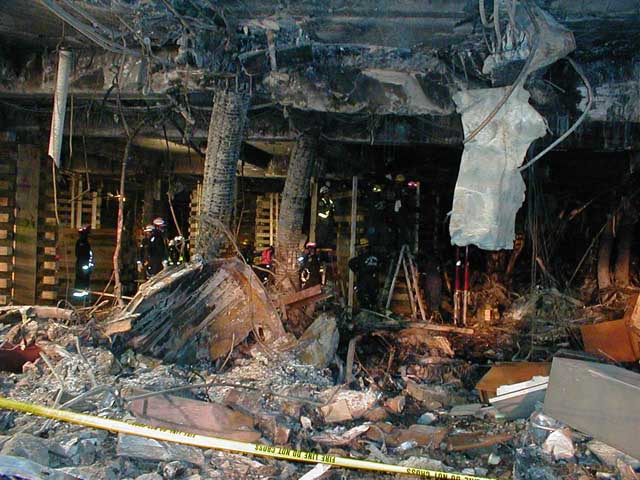
-
-
- Another photo of this hanging sheet of aluminum shows
a round circular metal part which does not appear to be normal building
debris (photographed by VATF-1 workers):
-
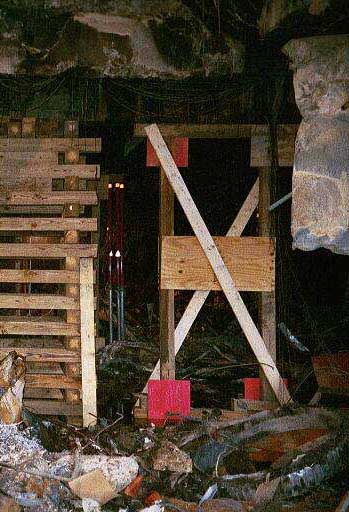
-
-
- This photo of engine remains was taken in either D or
C-ring by VATF-1 workers. The large circular piece in the middle appears
to be the diffusor section of the compressor, though this is not known
for certain. Note the torn column nettings on the right. On the left is
an obvious piece of yellow-primed aircraft fuselage bearing rivet holes
and a twisted silver metal piece next to it.
-
-
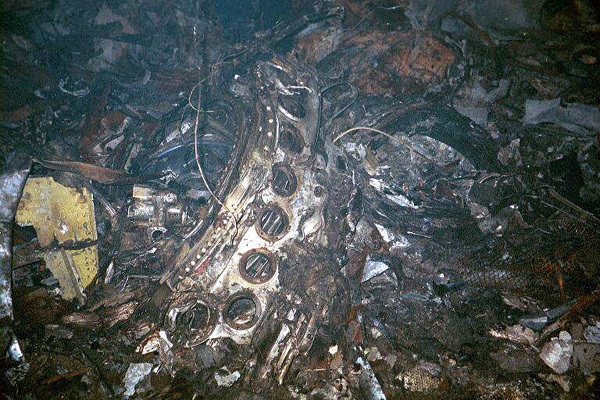
-
-
- Now we are moving to the C-ring punchout hole. The following
photo taken on 9/13 or 9/14 gives a unique view of the hole from the inside,
unfortunately after most of the debris was hauled away:
-
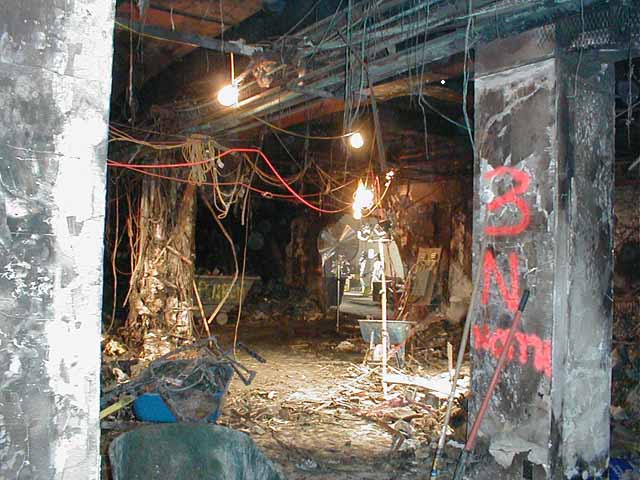
-
-
- However the following photo shows a landing gear found
inside C-ring near the punchout hole. Note how completely charred the rest
of the debris was.
-
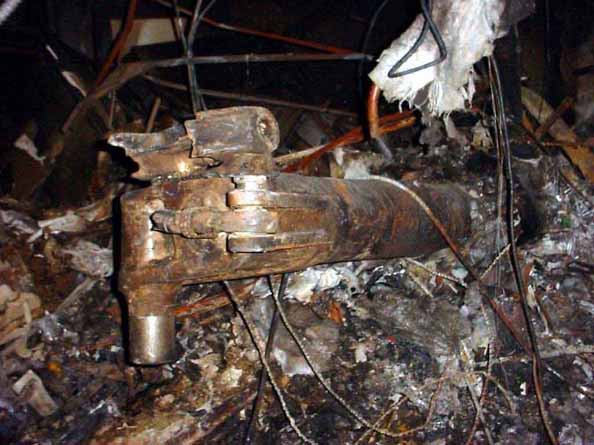
-
- As other witnesses related, debris lying outside the
C-ring punchout hole in A-E Drive included a chunk of nose fuselage or
nose cone, a landing gear, and an aircraft tire tread.The following photo
(by Fort Belvoir photographers) shows two pieces of fuselage debris (note
the green primer) lying in front of the hole. Note a ring of 8 small holes
on the larger piece. A similar ring of 8 holes may be found on a 757 nose
(with an attaching piece), just below the cockpit windows -- but it is
far from clear whether the configuration is a match. This larger piece
of debris may be the fragment of "nose cone" referred to by Lt.
Kevin Shaeffer and Victor Correa.
-
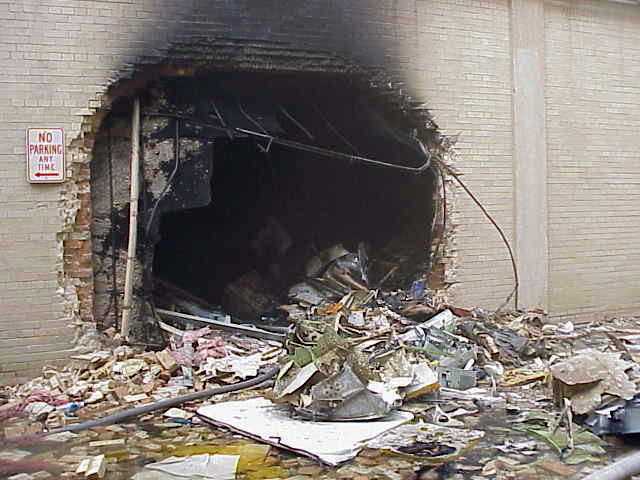
-
-
- In the heap of debris next to the hole lies an airliner
wheel hub from one of the landing gears (as shown on TLC's "Pentagon
Under Fire," aired 9/11/02):
-
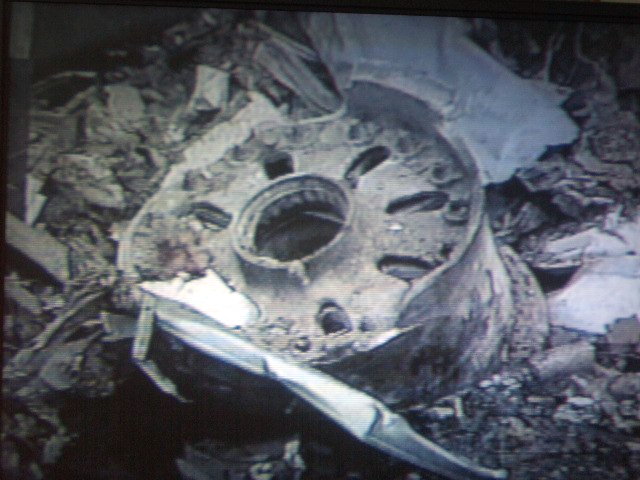
-
-
- Compare the following closeup of a 757 landing gear:
-
-
-
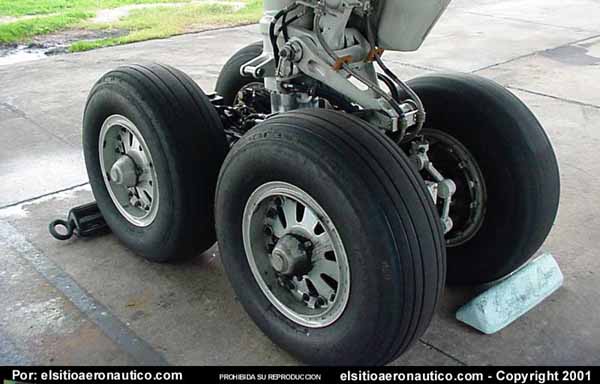
-
-
-
- The following photo, which ironically enough graced the
cover of T. Meyssan's "Pentagate" book, shows both the fuselage
fragment and the wheel hub:
-
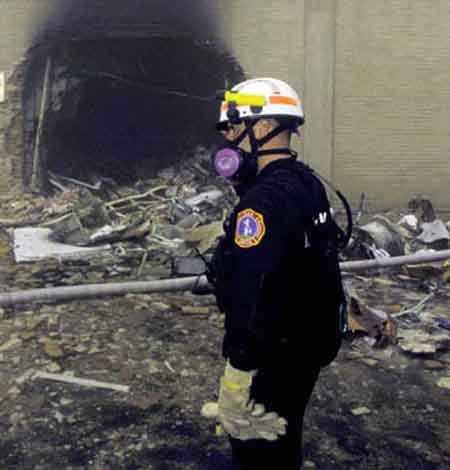
-
-
- Finally, further down the debris heap, one can find the
tire tread that belonged to the wheel hub. I've indicated it in the following
video still recorded in A-E Drive:
-
-
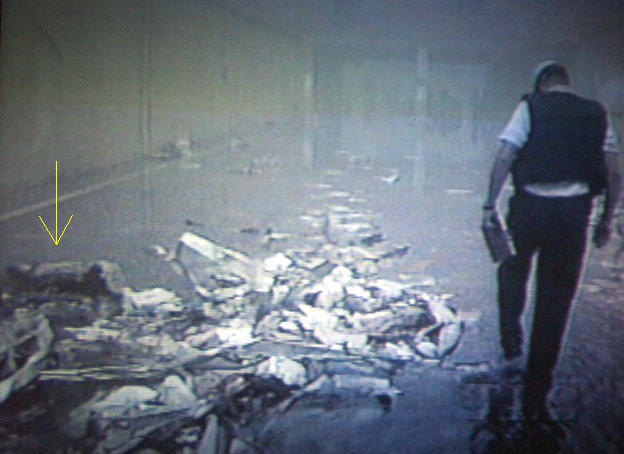
-
-
-
-
- Another image of the tire tread, published in Paris
Match and posted on the web by AmigaPhil, shows its groove markings more clearly.
I've compared it with a landing gear recovered at the WTC, and the grooves
appear to match:
-
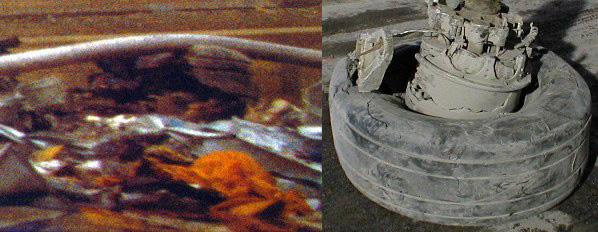
-
-
-
- III. Conclusion
-
- Despite the destructive fire that raged inside the impact
area on 9/11, pieces of debris were visible on 9/13 and 9/14, and were
photographed by recovery workers. These photos clearly show pieces of landing
gears, a large turbofan engine, and fuselage. The evidence inside the building
is consistent with the evidence of plane wreckage outside -- indicating
that a commercial airliner flew into the Pentagon on September 11th.
|